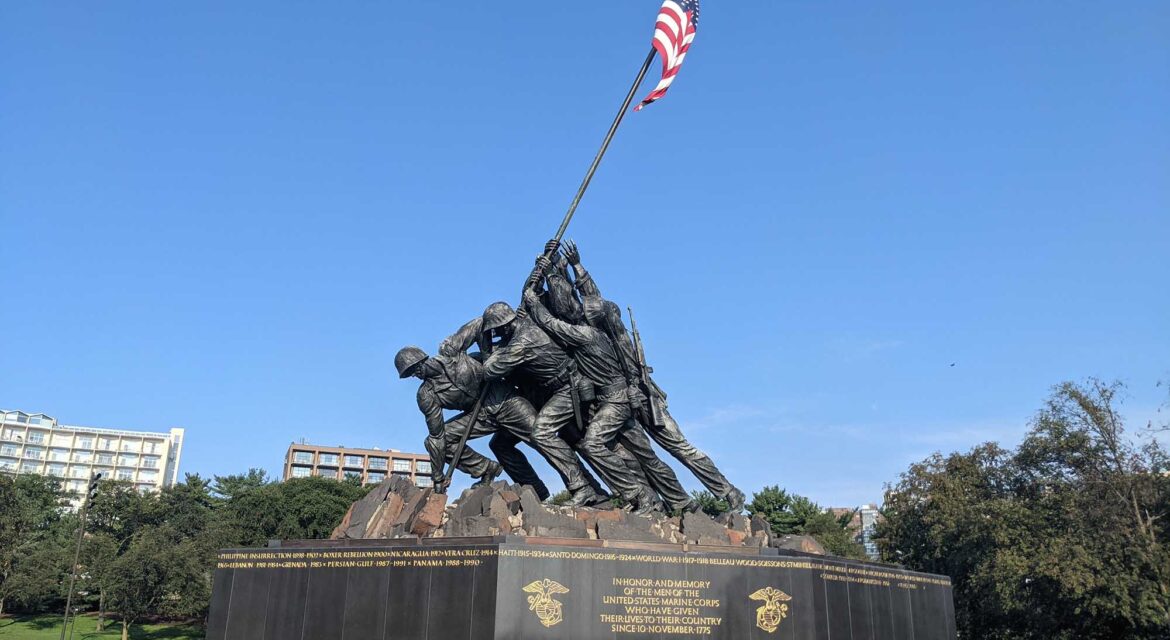 Depicting one of the most famous scenes of World War II, the United States Marine Corps War Memorial is dedicated to all Marines who gave their lives in defense of the United States of America. Located within the George Washington Memorial Parkway in Arlington, Virginia, the monument is the main feature of a small complex that contains walking paths and places to view the monumentous landmark that celebrates the history and legacy of an entire nation in a way that’s as powerful as it is enduring.
Depicting one of the most famous scenes of World War II, the United States Marine Corps War Memorial is dedicated to all Marines who gave their lives in defense of the United States of America. Located within the George Washington Memorial Parkway in Arlington, Virginia, the monument is the main feature of a small complex that contains walking paths and places to view the monumentous landmark that celebrates the history and legacy of an entire nation in a way that’s as powerful as it is enduring.

Based on an Iconic Photograph
 The United States Marine Corps War Memorial is a larger-than-life sculpture of the Marines who raised one of the American Flags on Iwo Jima in 1945. This depiction is inspired by the photo that was taken by combat photographer Joe Rosenthal. This photo was captured atop Mt. Surabachi on the island of Iwo Jima and became regarded as one of the most significant and recognizable images of World War II.
The United States Marine Corps War Memorial is a larger-than-life sculpture of the Marines who raised one of the American Flags on Iwo Jima in 1945. This depiction is inspired by the photo that was taken by combat photographer Joe Rosenthal. This photo was captured atop Mt. Surabachi on the island of Iwo Jima and became regarded as one of the most significant and recognizable images of World War II.
Funding for the United States Marine Corps War Memorial began soon after the war in 1947 with the establishment of a federal foundation with funds provided by Marines and their friend. A commission from Congress for the memorial was awarded in 1951, with the piece being dedicated in 1954 by President Dwight D. Eisenhower. The monument would be dedicated to “the Marine dead of all wars and their comrades of other services who fell fighting beside them.”
Created by Felix de Weldon, the monumentous sculpture depicts the group of six Marines who raised the flag. The Marines who were believed to be the surviving flag raisers had their faces modeled for the piece. All available pictures and physical statistics of the other three who had given their lives were collected and then used in the modeling of their faces. The identities of the six flag raisers have since been researched by the U.S. Marine Corps, with each of their names now confirmed.
Cast in bronze, these thirty-two-foot high figures raise a 60-foot bronze flagpole in an incredible display of technical ingenuity. Each of the figures occupies the same positions as they were originally identified in the photograph. They stand on a rock slope above a granite base at a total height of just under 80 feet. The names and dates of every principal Marine Corps engagement since the founding of the Corps form a gold ring around the base.
Features across the site include the Reviewing Stand as well as multiple interpretive exhibits. These features provide audiences with incredible ways to see and understand the context of the monument, but they are not the only means of engagement at the site. During the summer, the US Marine Corps normally holds Sunset Parades at the Memorial on Tuesday evenings. A one-hour performance, the Sunset Parade features the music of “The Commandant’s Own”, The United States Marine Drum and Bugle Corps and precision drill by the Marine Corps Silent Drill Platoon. The Sunset Parade is open to the public at no charge.
These activities are just part of the appeal of the United States Marine Corps War Memorial. Located on a high ridge, overlooking the national capital, the monument physically dominates the space and has cultivated activity on multiple levels due to how it is connected to a recognizable piece of history. However, the scope and spirit of the piece are what has ensured it will continue to resonate with audiences across the eras.

Connecting Individuals, Events and Eras
 With a direct connection to the history and legacy of an entire nation, the United States Marine Corps War Memorial has become an attraction that is utilized on everything from maps to merchandise. In being able to define an identity that is utilized in large and small ways, the monument honors the past at a scale and scope that will carry it into the future. It showcases how such monumentous landmarks can connect individuals, events and eras in ways that are as powerful as they are totally unique.
With a direct connection to the history and legacy of an entire nation, the United States Marine Corps War Memorial has become an attraction that is utilized on everything from maps to merchandise. In being able to define an identity that is utilized in large and small ways, the monument honors the past at a scale and scope that will carry it into the future. It showcases how such monumentous landmarks can connect individuals, events and eras in ways that are as powerful as they are totally unique.

